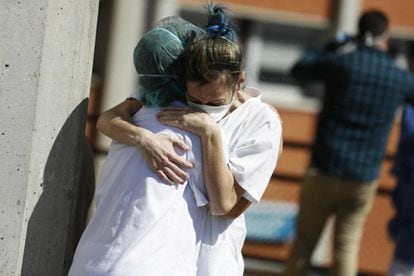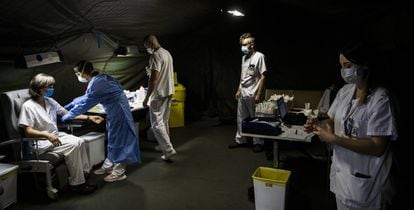How Europe underestimated the danger of the coronavirus pandemic
A review of the minutes from a meeting of the continent’s top health experts in February reveals that there was little understanding of how great a risk Covid-19 posed to the population
/cloudfront-eu-central-1.images.arcpublishing.com/prisa/YBHSTHVJ4GEI3IJTBR3S6UNHSE.jpg)

It’s Tuesday, February 18, and Europe is on the brink of the worst epidemic in a century. In just three days’ time, Italy will discover that the SARS-CoV-2 virus has been silently spreading in the north of the country. Over the coming days, the rest of Europe will make similar discoveries. The virus, as it will later be revealed, has entered senior residences and the lungs of intensive care patients across the continent.
But that Tuesday, the 30 people who were beginning a two-day meeting in the headquarters of the European Centre for Disease Prevention and Control (ECDC) in Solna, Sweden, do not recognize the risk. They are the members of the ECDC’s Technical Advisory Committee, the guardians of public health in Europe. Among this group is Fernando Simón, the director of the Spanish Health Ministry’s Coordination Center for Health Alerts and Emergencies and the man who has been offering daily figures on coronavirus deaths and infections in Spain since March. The meeting revolves almost completely around a problem that is considered under control.

A review of the minutes from this meeting, to which EL PAÍS has had access, is disconcerting. Reading this document three months and more than 166,000 global fatalities later, it is evident that no health official present there foresaw what was about to happen. The Technical Advisory Committee believed that Covid-19 presented a “low” risk to the European population, and only a few warnings were raised about the danger of the virus, the need to detect whether it was already in Europe, and the need for measures to stop it from spreading. But these warnings only comprised around 20 points on a 130-point document summarizing the deliberations of the two-day meeting.
All actions appeared to be left for a future date, and some proposals were postponed until two or three weeks later. The health officials from Austria and Slovakia said that it would be unwise to spark fear among the population, while Fernando Simón warned against the risk of “stigmatizing” people getting tested for Covid-19. When asked what he meant by this on Monday, Simón replied that he was referring to the need to “control the transmission” of the virus, rather than focus on a few individual cases.
Most of the meeting was spent discussing technical and preparatory details, such as what criteria should be used to test suspected cases of the virus, which would erupt across the continent in less than 72 hours.
The ECDC is an organization with few powers. Its goal is to provide expertise and proposals for coordination so that countries can more effectively protect the health of their population, an objective that was not met in the wake of the coronavirus crisis. The minutes show signs of the coming disaster, yet proposals to address the problem were left in limbo.
False sense of calm
By the time the meeting took place, there were 45 confirmed cases of coronavirus in Europe. All of these cases had either been imported or transmitted to one of their contacts. An 80-year-old Chinese tourist from Wuhan, the city where the coronavirus pandemic originated, had also died in Paris. The ECDC studied these cases and underscored that local contagion “appeared to be minor,” with few infections that were easy to track. This led the group to conclude that the virus presented a “low” risk to Europe and a “low to moderate” risk to the health system.
Mike Catchpole, the chief scientist at the ECDC, warned, however, about the high transmission rate after reviewing the first two coronavirus outbreaks recorded in Europe – one in a German company, and another in a ski resort in the French Alps. The representative from Germany expressed his misgivings about the containment strategy that was being followed at the time, arguing: “It has not worked because diseases do not respect borders.” The German official also suggested taking more steps, but apparently without any success.
No trace of the virus
At this point, the SARS-CoV-2 virus was spreading throughout Europe, but was not being detected by healthcare systems. The reason for this was the definition of a coronavirus case and the criteria used for testing. Under this criteria, a patient must have traveled to Wuhan in order to be tested. This meant that no tests were being carried out on people showing coronavirus symptoms, or on intensive care patients with pneumonia of unknown origin.
The technical committee agreed on this criteria in February and only appeared to waver when the representative from Denmark argued: “It is important to know where and when to look for the virus.” “For example, in the case of severe pneumonia it would be logical to look for the virus,” he added the next day.
The representative from the Netherlands explained that a group of doctors had been tasked with collecting samples to analyze. He urged taking a “proactive” approach and getting “ready” to manage outbreaks such as those reported in Japan and Vietnam. What is certain, however, is that the criteria for testing was not changed until February 25, four days after Italy recorded its first two coronavirus fatalities.
Shortage of tests
When the crisis hit, several European countries found that they did not have enough tests to diagnose all suspected cases of Covid-19. The meeting in February foresaw this problem. The committee suggested that travelers coming from countries such as Japan, Vietnam and Singapore, which had begun to detect community transmission of the virus, should also be tested for Covid-19. But the representative from Finland warned that this would be “unsustainable.” He explained: “This would lead many people to ask for tests, most of which would come back negative, but the burden on the health system would be enormous.”

The representative from Germany said that protocols for PCR tests, the most reliable detectors of the virus, had been distributed “to more than 20 hospitals,” while more than 1,000 tests had been carried out. It was an early indication of how Germany, the country which has made the most effort in testing suspected cases, would approach the pandemic in the future.
Shortage of face masks
When Germany tried to buy personal protective equipment (PPE) for its health workers, it found the international market “empty” of stock, the German health official explained at the meeting, noting the difficulties of encouraging “national production.” The representative from the Netherlands stated that “there is very little PPE available,” while the Irish official said that the country had “declared a health emergency and is stocked.” The minutes from the meeting do not indicate whether Fernando Simón said something at this point. What is known is that on March 8, as the pandemic was taking hold of Spain, the country did not have enough PPE for health workers. Two days later, the Spanish Health Ministry would try to centralize all PPE purchases rather than have each regional government procure its own supplies, a move that did little to solve the problem.
There is just one mention in the minutes of what would eventually become one of the major problems of the coronavirus crisis: overwhelmed hospitals. The only reference to this issue was made by the representative from the Netherlands, who said his country “could have problems with bed capacity in hospitals and that the main concern lies in adopting measures to slow and mitigate the epidemic.”
An underestimation
“They underestimated the virus,” said Daniel López Acuña, a former official at the World Health Organization who currently teaches at the Andalusia School of Public Health, after reading the minutes from the ECDC meeting. It is a position shared by all sources consulted by EL PAÍS. “Even looked at from the perspective of back then, with what was already known [about the coronavirus], it can be seen that neither the transmission capacity of the virus or the impact of international travel were adequately assessed,” he added.
“The fear over what happened with H1N1 [swine flu], when governments were later criticized for having invested in prevention, had an influence [on the response to the coronavirus crisis],” explained an EU source who wished to remain anonymous. During that health crisis, EU agencies were accused of taking action that led to a “waste of large sums of public money, and unjustified scares and fears about the health risks faced by the European public,” as claimed in a 2010 report from the Council of Europe.
Joan Ramon Villalbí, a member of the board of the Spanish Society of Public Health and Administration (Sespas), agreed that the experience of the first SARS and MERS epidemics “did not indicate at any point a propagation” comparable to that which has turned the coronavirus into a global pandemic.
English version by Melissa Kitson.
/cloudfront-eu-central-1.images.arcpublishing.com/prisa/OAS62CFEQBHHHPAMUCUX4IFH7E.JPG)
/cloudfront-eu-central-1.images.arcpublishing.com/prisa/UIBINQL3UJBNTNINAY5F4STQYU.jpg)










































